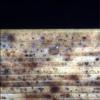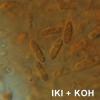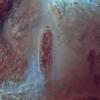
26-03-2016 21:50
 Bernard CLESSE
Bernard CLESSE
Je reste dans les Mniaecia avec cette belle espèc

24-03-2016 20:56
Thorben HülsewigHi there,today i found in a mixed forest (Quercus/

26-03-2016 09:35
 Angel Pintos
Angel Pintos
Ascoma de color rojo en grupos.En KOH se vuelve m�

24-03-2016 07:10
 Christopher Engelhardt
Christopher Engelhardt
Time and again I struggle with these Ascobolus on
I regrettably did a poor job characterizing this specimen last year, but I wonder if someone recognizes it? I believe it is in the Hemiphacidiaceae but I am unaware of a species like this on grass.
Collected in the spring from dead grass leaves (possibly Typha latifolia) in a damp environment.
The ascomata are ca. 350 um diam, erumpent, leaving a small flap of host tissue as they emerge. The asci are eumayloid, parpahyses lanceolate and exceeding the length of asci, ascospores 6-7 x 2-2.5 um.
I wish I had more images (especially vital in water), however this is basically all I have. I did manage to culture it at least.

there is actually a Hysterostegiella typhae, and I believe it is this species.
Please let me know if you find anything interesting with your culture.
We have merged this family in the Cenangiaceae (see my poster on invivoveritas). For Hysterostegiella I cannot remember a single existing sequence!
Zotto
The cultures looks as if they are trying to produce ascomata, but nothing so far. I will try to sequence it in the near future and let you know the results.
Thank you very much, it is great to get a name on this one.








